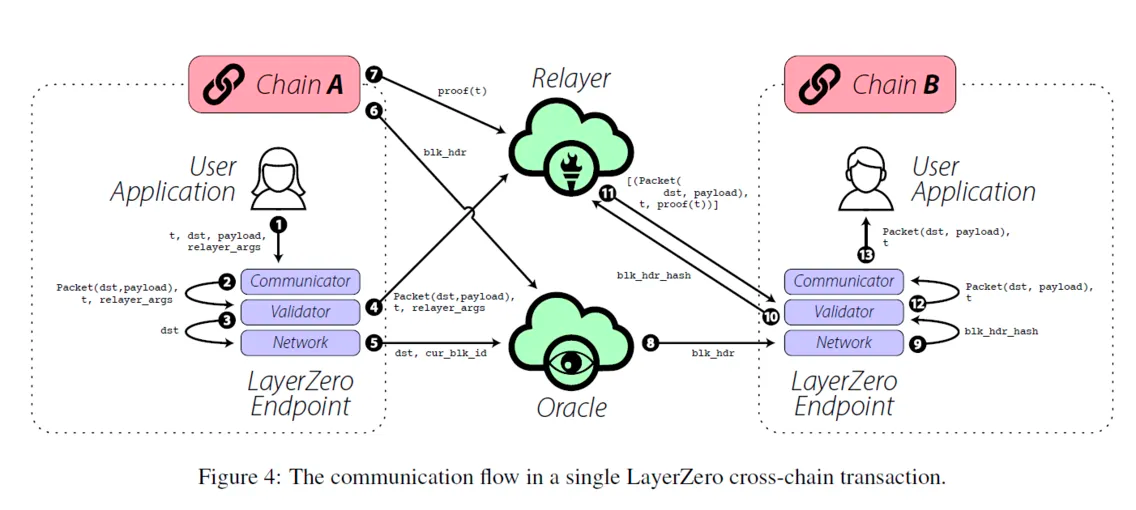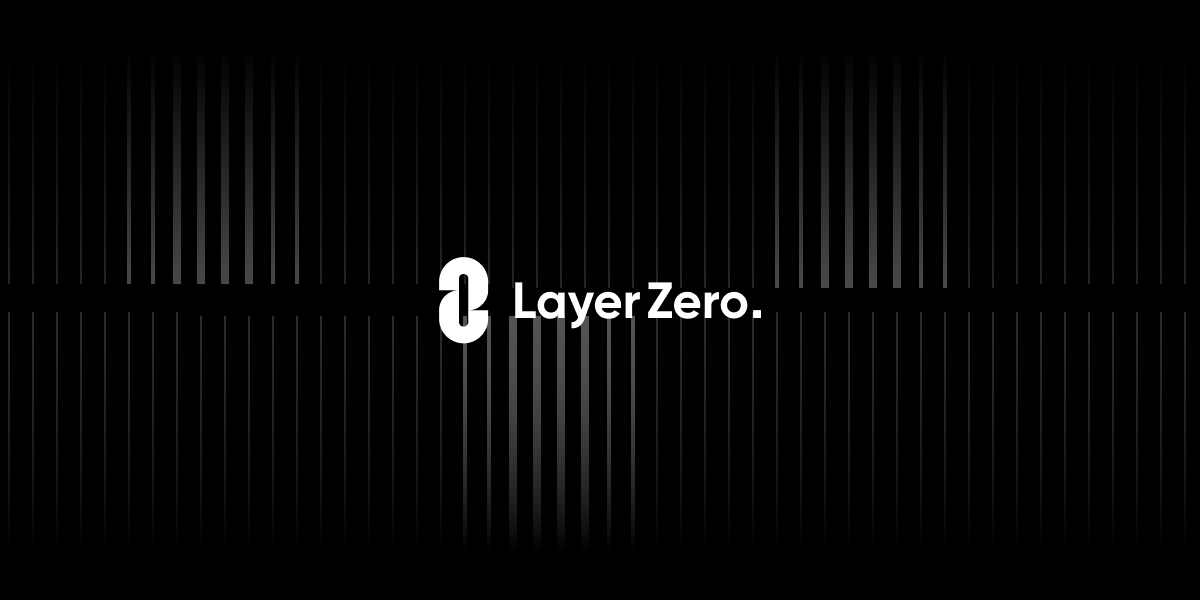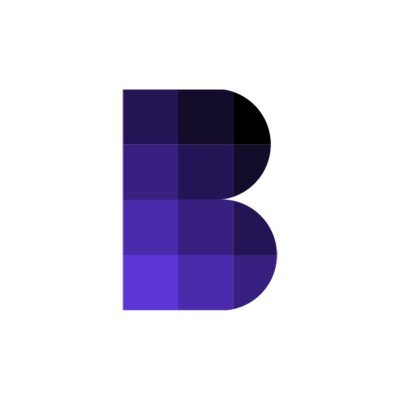The multi-chain collaborative development has become an inevitable trend in the future of blockchain technology. It brings a higher degree of freedom for the development of blockchain, but at the same time, it also brings serious problems: public chains established based on their own characteristics are increasingly isolated, and users' mobility is limited within walled gardens. Although some leading applications have attracted a huge amount of user traffic and seemingly occupied a large market share, the market confined within walled gardens, no matter how big it is, would only be a puddle compared to the outside world. To truly realize Web3.0 in the future, we need a basic network that can achieve full-chain interoperability, and LayerZero is such a fundamental protocol. Recently, LayerZero has completed a Series B financing of $120 million with a valuation of $3 billion, with well-known blockchain investment institutions like a16z Crypto and Sequoia Capital participating. The favor of capital also implies that the era of full-chain is coming soon.
From Cross-Chain to Whole-Chain, LayerZero Represents the New Trend in Cross-Chain Technology
As the blockchain industry continues to evolve, more and more Layer 1 and Layer 2 blockchain networks have emerged, playing an important role in the rapid expansion of the blockchain ecosystem. However, due to the differentiation and continuous expansion of different public chains' ecosystems, users' liquidity is restricted and information cannot flow freely. This problem of liquidity fragmentation is becoming increasingly serious, posing great challenges to blockchain applications and development. Therefore, in the era of multi-chain coexistence, it has become extremely important to solve the interoperability problem between public chains.
Currently, there are two main types of cross-chain communication methods: the first is a middle chain that forms a consensus and verifies and forwards messages between different chains, known as a middle chain; the second is to run a node on the chain to achieve message transmission, known as an on-chain light node.
In the first mode, the middle chain has complete signing authority over all information, and this design is extremely susceptible to consensus corruption at a single point, resulting in the theft of all liquidity on the chains. Currently, middle chains are bound to billions of dollars but protect hundreds of billions of dollars in security. Moreover, middle chains are becoming increasingly decentralized and more likely to be exploited by criminals. In the second mode, on-chain light nodes can receive and verify the block headers of each set of blockchains on opposing chains, and using a light node to transmit information is the most secure, but also the most expensive. Currently, running an on-chain light node on Ethereum for each opposing chain costs thousands of dollars a day. Both modes have their own advantages and disadvantages, with middle chains being cheaper but less secure, while on-chain light nodes are secure but expensive.
Whether middle chains or on-chain light nodes, they are essentially a cross-chain application created to meet the information interaction between specific public chains in a multi-chain ecosystem. They can be seen as an attempt or exploration of cross-chain technology in a multi-chain ecosystem. However, if we want to achieve smooth interaction with all public chains through a single application in a multi-chain ecosystem, and without the need to frequently switch wallets, it will never be possible to rely solely on building more middle chains or on-chain light nodes between public chains. Therefore, cross-chain needs to enter a new stage: using the lowest-level protocol to construct a universal cross-chain protocol to achieve whole-chain interaction. LayerZero is such a whole-chain protocol.
From the beginning, LayerZero did not simply position itself as an ordinary asset cross-chain bridge, but hoped to become a more fundamental infrastructure-level protocol than Layer 1 public chains, thus completely solving the liquidity fragmentation between many public chains and the deep-seated problem of frequent wallet switching for use with applications in the future. In LayerZero, we see not only simple cross-chain functions but also a rich cross-chain ecosystem built on the LayerZero protocol. Currently, representative whole-chain products built on LayerZero include Stargate and Radiant, among others, and with the continued development of the LayerZero ecosystem, more native cross-chain products based on the LayerZero protocol are expected to emerge in the future.
LayerZero is paving the way for an interoperable new era
Interoperability remains one of the biggest challenges facing blockchain technology. Currently, most blockchains operate in isolation, making it difficult to transfer data, assets, and information between them. As more and more blockchains emerge, communication and transactions between them are becoming increasingly important. This is where LayerZero comes in. LayerZero's underlying technological advantages and rich application scenarios are paving the way for secure, trustless, and efficient interoperability.
LayerZero operating mechanism
LayerZero achieves decentralized cross-chain information services by deploying a series of smart contracts (Endpoints) on the chain. The Endpoint runs a super light node, which is "super light" in that it only provides the Block header of the designated block.
In addition, two external services are used in the information transfer process: Oracle and Relayer.

Oracle is a third-party service that provides a mechanism for reading block headers from one chain and sending them to another. The LayerZero team has chosen to use Chainlink and Band Protocol as their official oracles. However, theoretically, any oracle service provider can be part of this mechanism. The Relayer is an off-chain service whose function is similar to that of the Oracle, but its function is to obtain proof of a specified transaction. The Relayer and Oracle must be independent to ensure the effectiveness of message passing.
In practical operation, if you want to use LayerZero to send a message from Chain A to Chain B, you first need to notify the Oracle and Relayer on Chain A that you want to send a message. Then the Oracle sends the relevant block header (the summary of the latest transaction on Chain A) to the super light node on Chain B. Then the Relayer on Chain A will submit the proof of this transaction to Chain B. Once this proof is validated on Chain B, the message can be sent to the intended recipient on Chain B. One of the benefits of this method is that it is both secure and cost-effective, as it combines the advantages of the middle-chain and on-chain light-node methods while eliminating their weaknesses.
LayerZero advantages
Universality
Traditional IBC cross-chain protocols require deployment of light nodes of other public chains on the public chain. However, the high gas fees limit the application of IBC protocols on Ethereum and other EVM-compatible chains. This greatly reduces the universality of the IBC protocol, and it can currently only be used in the relatively small Cosmos ecosystem. In contrast, LayerZero greatly reduces the integration cost of public chains by adopting a super light node technology architecture. Mainstream public chains, especially Ethereum and other EVM-compatible chains, can almost bear the cost of deploying LayerZero nodes. Therefore, Layerzero has strong universality and may become the underlying protocol for integrating cross-chain functions of various EVM public chains in the future.
Scalability
Scalability has always been a challenging obstacle for blockchain solutions, but LayerZero has overcome this problem. Moreover, it has brought more extensive application scenarios to the blockchain ecosystem, such as data validation, personal reward structure setup, and digital currency packaging. As the foundational layer, LayerZero can achieve cross-chain interoperability with Layer 1 protocols such as BTC, ADA, and ETH. Operators can deploy relay networks between multiple nodes, such as Bitcoin and Ethereum, with the help of LayerZero. Compared to patching the underlying protocol of existing blockchain networks, LayerZero is modular and scalable, allowing for the addition of new chains and functionalities without modifying the core protocol. This makes it a more flexible and scalable solution.
Efficiency
Compared to other cross-chain projects, LayerZero can achieve higher transmission efficiency, mainly due to its unique design. LayerZero's "super-light node" adopts a verification mode similar to IBC light nodes, which greatly reduces the cost of verification while ensuring security. Unlike the cumbersome solutions of traditional light nodes that need to save the other party's block headers, LayerZero's "super-light nodes" obtain the required block headers on-demand through oracles and verify transactions. This approach maximizes the reduction of the associated costs and processing time of cross-chain transactions, improving transmission efficiency.
Security
As a foundational protocol, LayerZero's security is independent of external protocols. Even if there are security issues or attacks on external protocols, it will not affect the security of LayerZero, thereby ensuring the stability of the entire protocol consensus. In addition, LayerZero's unique oracle and relay design also maximizes the security of information transmission. The oracles and relays maintain independence from each other, even in the worst-case scenario where they are run and collude by the same entity. This is only an isolated risk, the probability of success is minimal, and the cost of attack for malicious actors will be very high. Furthermore, to further reduce risk, LayerZero allows users to choose different oracle/relay combinations for their applications, and users can even run relays themselves. These measures provide the most secure guarantee for information transmission.
LayerZero Use Cases
Cross-chain Decentralized Trading: LayerZero supports cross-chain DEX specialized in handling native assets. Compared to existing DEX that issue wrapped tokens or use intermediary side chains, LayerZero's design allows for liquidity pool swaps across different chains using inter-chain message passing. Users simply deposit their native assets into a pool and extract native assets on another chain. LayerZero's message passing capability is powerful and enables direct bridging (1:1 price pegging), automated market making (ab=k price pegging), and any other derivatives (e.g. Curve DAO pricing). Additionally, LayerZero's efficient delivery guarantee makes broad decentralized exchange applications possible.
Multi-chain Yield Aggregator: Current yield aggregators typically operate within a single chain ecosystem, with projects such as Yearn Finance implementing a single chain strategy for corresponding yield aggregation. However, these single chain yield aggregator systems have a major weakness in that they cannot take advantage of any yield opportunities outside the current ecosystem, potentially missing out on many beneficial investment opportunities. By using LayerZero for cross-chain trading in yield aggregators, users can devise more strategic investment plans, allowing them to leverage the best opportunities across all ecosystems and increase the likelihood of obtaining high yield opportunities. Compared to single chain yield aggregators, multi-chain yield aggregators are superior because in the worst case, the strategy only uses opportunities on a single chain, while in the best case, there are more opportunity choices.
Multi-chain Lending and Borrowing: Previously, users did not have a simple way to take advantage of blockchain opportunities that are not within their asset holding range. For example, users holding all assets on Ethereum wishing to gain yield on Polygon would either have to transfer all assets to Polygon and convert them to the desired currency, or borrow assets on Ethereum, then borrow the desired assets, and then bridge them to Polygon. However, through LayerZero's multi-chain lending and borrowing protocol, users can directly engage in MATIC lending on Polygon using assets they hold on Ethereum, eliminating intermediate costs such as bridging fees and exchange fees. This way, users can more conveniently use assets on different chains, maximizing their returns.
Unified Liquidity Bridge: Currently, liquidity bridges divide liquidity between bridge and bridge, and between pool and pool in order to attract competition among liquidity providers (LPs). This means that LPs must choose to connect to a single liquidity pool on a single chain to provide liquidity for assets. With LayerZero's unified liquidity bridge, unified liquidity can be provided on all chains, protecting the finality of source chains. This means that when a user transfers assets from Chain A to Chain B, their assets on Chain B are guaranteed. Additionally, LPs can charge fees from all transactions entering Chain B, not limited by the source chain, achieving more convenient and efficient cross-chain asset flow.
Swaps: Using LayerZero, developers can build complex cross-chain applications without sacrificing trustlessness or introducing complicated intermediary chains or smart contracts. Automated market makers can be easily packaged and cross-chain asset exchanges are made simpler - without requiring code modifications. For example, users can directly exchange ETH for SOL in a single Ethereum transaction without a middle token or a second transaction. The actual exchange protocol is handled by the smart contract on either chain in the cross-chain transaction, while LayerZero is responsible for transmitting information between the two chains. This approach provides flexibility and satisfies end-to-end principles.
These use cases are just a small part of the many possibilities that LayerZero can achieve, and as LayerZero's technology continues to evolve and its ecosystem matures, it will bring us more surprises and pave the way for the upcoming era of full-chain.
Ecological projects worth noting based on LayerZero
As a trustless protocol, LayerZero enables seamless communication between blockchains without compromising security and decentralization. Projects built on the LayerZero protocol can facilitate full chain cross-chain lending, cross-chain pledging and other functions. Here are a few noteworthy full-chain projects built on LayerZero:
Full-chain DEX - StargateFinance
Stargate is the first fully composable native asset bridge built by the community and the first Dapp built on LayerZero. Its vision is to make cross-chain liquidity transfer a simple and distinctive transaction process. Stargate successfully solves the Bridging Trilemma. With LayerZero raising Series B funding, Stargate's daily interactions have skyrocketed. Currently, users can perform cross-chain transactions of various assets such as USDC, USDT, DAI, STG, RDNT, and FRAX on Ethereum, BNB Chain, Polygon, Arbitrum, Optimism, Fantom, Metis, and Avalanche.
As a descendant of LayerZero, Stargate's role goes beyond being a cross-chain bridge. Stargate's goal is to be a technology provider for asset cross-chain, allowing more projects to easily use Stargate and achieve cross-chain functionality. Therefore, Stargate's business needs to be divided into two parts, 2B and 2C. The 2B business model has far more imaginative space than the 2C model, and more complex Dapps can be built on top of Stargate. Currently, Stargate has issued the STG Token. Holders can stake STG to not only receive protocol revenue dividends, but also exchange proportionate veSTG according to their staking period to participate in proposals, voting, and other community governance activities.
Full-chain NFT - GhostlyGhosts
Gh0stly Gh0sts is the first full-chain NFT series launched by LayerZero, with 7710 NFTs that can be minted for free on 8 supported blockchains. The design of this series is very ingenious, with each NFT's background color representing its birthplace. Ethereum is gray, BNB is yellow, Polygon is purple, Avalanche is red, etc. In the past, when popular NFTs were minted, Ethereum often experienced a spike in gas fees due to the consumption of a large amount of blockchain resources. However, GhostlyGhosts, based on the LayerZero protocol, can easily achieve multiple chain issuances, avoiding gas wars.
Full-chain lending market - Radiant
Radiant is a project dedicated to becoming a full-chain lending market, with the goal of unifying decentralized cross-chain liquidity in the Web3.0 currency market and sharing protocol fees with community users. Compared to traditional centralized exchanges, Radiant emphasizes seamless cross-chain liquidity connection, allowing users to deposit any mainstream asset on any chain and borrow any supported asset on other multiple chains. This also gives it a higher competitive edge in the full-chain currency market.
Radiant's underlying technology is based on LayerZero's OmniChain technology. It has launched the V1 version, which only supports cross-chain lending of ETH assets on Arbitrum. However, V2 is coming soon and will support more assets and public chains, further strengthening Radiant's position in the full-chain lending industry. In addition, Radiant has the first-mover advantage with a strong technical team like LayerZero supporting it. Currently, Radiant ranks third in TVL on the Arbitrum chain, and its future development potential is incalculable.
Summary
As blockchain technology continues to evolve, users and developers are increasingly aware of the importance of achieving interoperability between different blockchains. In order to fully harness the potential of blockchain technology, different blockchains must be able to interact securely, efficiently, and without trust. LayerZero, as an innovation in underlying technology, is greatly advancing this goal. Currently, LayerZero is connected to over 30 mainnet blockchains and is widely used in decentralized exchanges such as PancakeSwap, SushiSwap, Trader Joe, and Uniswap. LayerZero has processed over $6 billion in transactions and has locked up assets worth over $7 billion in total value. It is foreseeable that in the era of multi-chain coexistence in the future, LayerZero will become the basic network structure of the entire chain ecosystem, continuing to contribute to the progress and development of the blockchain industry.















